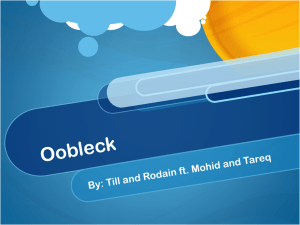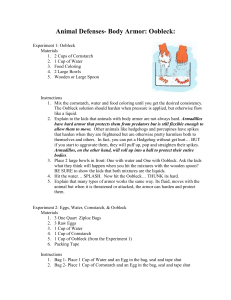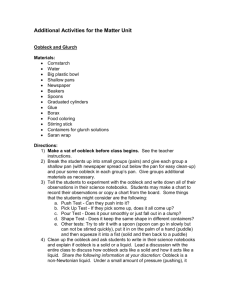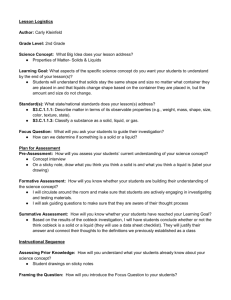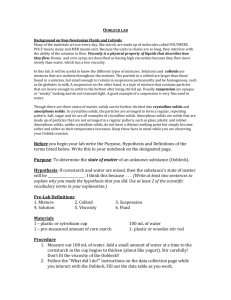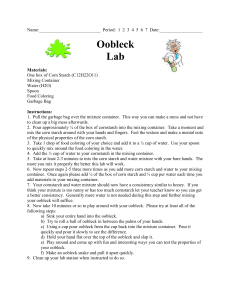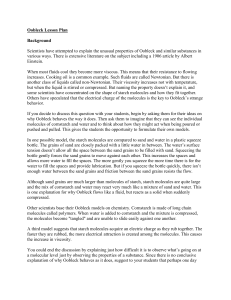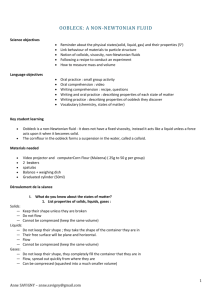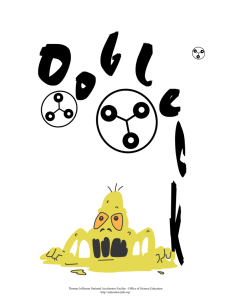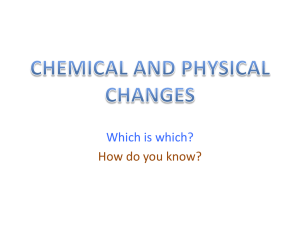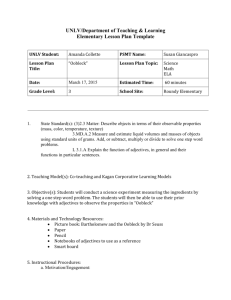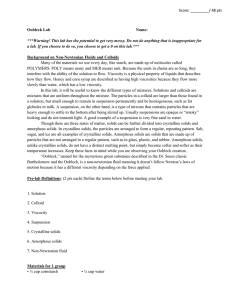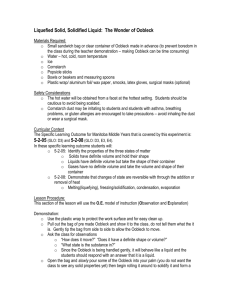Solids, Liquids, and...Oobleck
advertisement
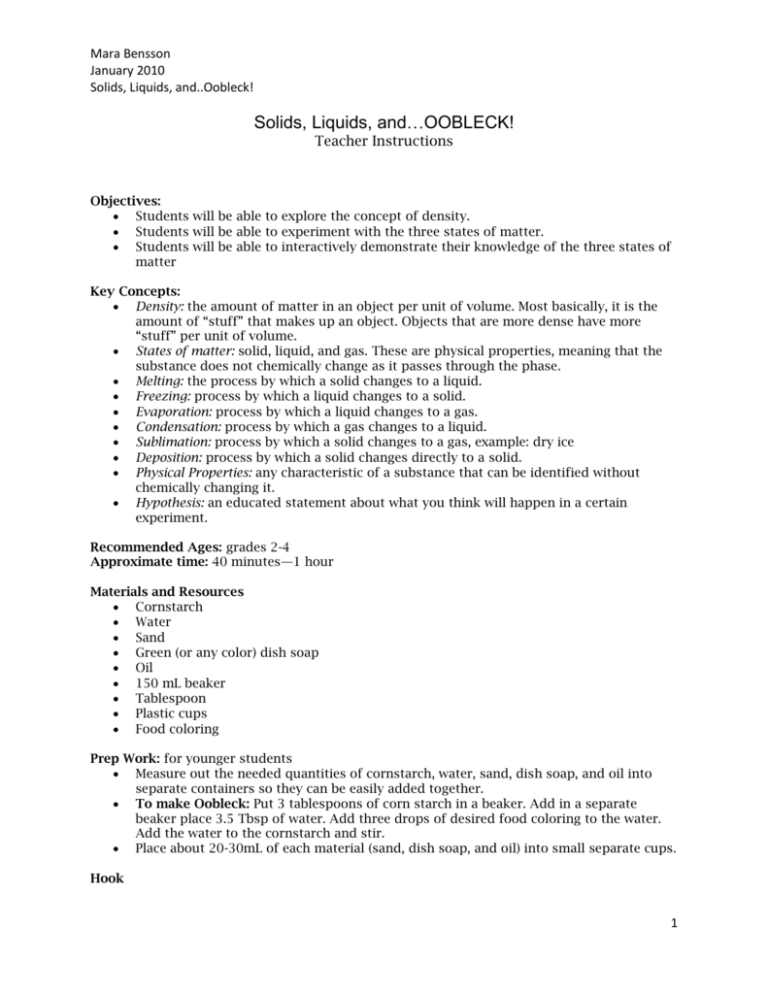
Mara Bensson January 2010 Solids, Liquids, and..Oobleck! Solids, Liquids, and…OOBLECK! Teacher Instructions Objectives: Students will be able to explore the concept of density. Students will be able to experiment with the three states of matter. Students will be able to interactively demonstrate their knowledge of the three states of matter Key Concepts: Density: the amount of matter in an object per unit of volume. Most basically, it is the amount of “stuff” that makes up an object. Objects that are more dense have more “stuff” per unit of volume. States of matter: solid, liquid, and gas. These are physical properties, meaning that the substance does not chemically change as it passes through the phase. Melting: the process by which a solid changes to a liquid. Freezing: process by which a liquid changes to a solid. Evaporation: process by which a liquid changes to a gas. Condensation: process by which a gas changes to a liquid. Sublimation: process by which a solid changes to a gas, example: dry ice Deposition: process by which a solid changes directly to a solid. Physical Properties: any characteristic of a substance that can be identified without chemically changing it. Hypothesis: an educated statement about what you think will happen in a certain experiment. Recommended Ages: grades 2-4 Approximate time: 40 minutes—1 hour Materials and Resources Cornstarch Water Sand Green (or any color) dish soap Oil 150 mL beaker Tablespoon Plastic cups Food coloring Prep Work: for younger students Measure out the needed quantities of cornstarch, water, sand, dish soap, and oil into separate containers so they can be easily added together. To make Oobleck: Put 3 tablespoons of corn starch in a beaker. Add in a separate beaker place 3.5 Tbsp of water. Add three drops of desired food coloring to the water. Add the water to the cornstarch and stir. Place about 20-30mL of each material (sand, dish soap, and oil) into small separate cups. Hook 1 Mara Bensson January 2010 Solids, Liquids, and..Oobleck! Have you ever heard of a substance that is part liquid and part solid? No? Well today is your lucky day. It’s time for OOBLECK, the NON-Newtonian substance! Procedure 1. Introduce the states of matter. Give students the first handout. Go through the handout and have students fill in the blank spaces. a. For each blank space as if they know an example of each phase and phase change. 2. Pass out second worksheet. Make the Oobleck. Ask students if they have ever heard of the non-Newtonian substance called Oobleck. a. For younger students allow a volunteer to come up and add the pre-measured water to the cornstarch. b. Allow a second student to stir. c. Once the Oobleck has reached a good consistency let students touch it to determine the its physical properties. i. Students should write on their sheets what the physical properties of Oobleck is. 1. What does it feel like? 2. Does it smell? d. Where does Oobleck fit on the chart we filled in earlier? 3. Density experiment. We will be determining how different solids and liquids act when they are all placed in the same container. Which one will be on the bottom? On the top? a. On the second worksheet, students will find three drawings of empty cups. Introduce density by explaining to them how different substances are heavier than others. 4. In the first cup on the paper have students draw where they think each substance (sand, oil, and dish soap) will settle in the cup. 5. Once they have done that, ask volunteers to come up and add the substances one at a time. a. Younger students should add the pre-measured substances. b. Older students should measure out the substances 6. Once everything has settled, have students draw out the result in the second empty cup. Which substance is the most dense? How do we know? 7. Once students have finished, ask them where they think the oobleck will fall. It’s not solid or liquid! a. Have older students write down a hypothesis. b. Younger students can simply say what they think will happen. 8. Allow a volunteer to pour in the Oobleck. Once it settles, have students draw the results in the third empty cup. 9. Were our hypotheses correct? a. What does this experiment tell us about the density of Oobleck? b. What does the whole exercise tell us about each liquid/solid? More Discussion Topics What is a gas? Can we see it? o Where is the gas located in the cup with all the liquids and solids in it? Have students draw in gas where they think it belongs in their cups. o What does this tell us about the physical properties of gases? List physical properties. o What are chemical properties? o What is a chemical change? o What is a physical change? 2 Mara Bensson January 2010 Solids, Liquids, and..Oobleck! Name: ____________________________________________________________________________ (1) Draw where you think the sand, dish soap, and oil will fall when mixed together: (2) Draw where the sand, dish soap, and oil ACTUALLY fell: 3 Mara Bensson January 2010 Solids, Liquids, and..Oobleck! (3) Draw where you think the Oobleck will fall in the mixture: (4) Draw where the oobleck actually fell: 4 Mara Bensson January 2010 Solids, Liquids, and..Oobleck! Name: _____________________________________ Draw an example of the 3 words listed below: Solid Liquid 5 Mara Bensson January 2010 Solids, Liquids, and..Oobleck! Gas Name: _________________________________________________________ Date: __________________________________________________________ Solid Gas Liquid 6
